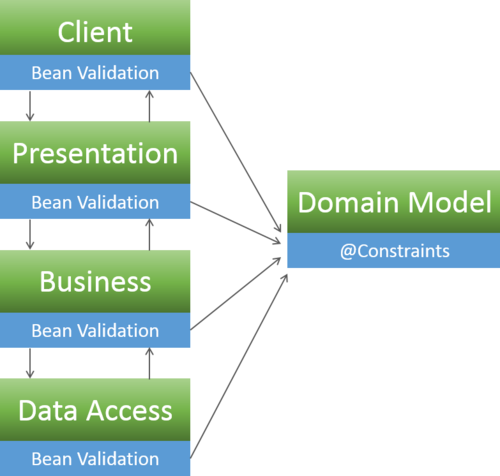This site is the archived OWASP Foundation Wiki and is no longer accepting Account Requests.
To view the new OWASP Foundation website, please visit https://owasp.org
Difference between revisions of "Bean Validation Cheat Sheet"
| Line 1: | Line 1: | ||
| − | [[Image: | + | [[Image:Bean_validation_jsr.png|500px|frameless|architecture]] |
[[Image:Bean_validation_typical.png|500px|frameless|architecture]] | [[Image:Bean_validation_typical.png|500px|frameless|architecture]] | ||
Revision as of 01:03, 8 June 2016
Introduction
This article is focused on providing clear, simple, actionable guidance for providing Java Bean Validation security functionality in your applications.
Bean validation (JSR303 aka Bean Validation 1.0 /JSR349 aka Bean Validaiton 1.1) is one of the most common ways to perform input validation in Java. It is an application layer agnostic validation spec which provides the developer with the means to define a set of validation constraints on a domain model and then perform validation of those constraints through out the various application tiers.
One advantage of this approach is that the validation constraints and the corresponding validators are only written once, thus reducing duplication of effort and ensuring uniformity:
Typical validation:
Image placeholder
Bean Validation:
Image placeholder
Setup
The examples in this guide use Hibernate Validator (the reference implementation for Bean Validation 1.1).
Add Hibernate Validator to your pom.xml :
<dependency>
<groupId>org.hibernate</groupId>
<artifactId>hibernate-validator</artifactId>
<version>5.2.4.Final</version>
</dependency>
Enable bean validation support in Spring's context.xml
<beans:beans ... ... <mvc:annotation-driven /> ... </beans:beans>
For more info, please see the setup guide
Basics
In order to get started using Bean Validation, you must add validation constraints (@Pattern, @Digits, @Min, @Max, @Size, @Past, @Future, @CreditCardNumber, @Email, @URL, etc.) to your model and then utilize the @Valid annotation when passing your model around in various application layers.
Constraints can be applied in several places:
- Fields
- Properties
- Classes
For the sake of simplicity all the examples below feature field constraints and all validation is triggered by the controller. Refer to the Bean Validation documentation for a full list of examples.
When it comes to error handling, the Hibernate Validator returns a BindingResult object which contains a List<ObjectError>. The examples below feature simplistic error handling, while a production ready application would have a more elaborate design that takes care of logging and error page redirection.
Pre-defined Constraints
@Pattern
Model
import org.hibernate.validator.constraints.Pattern
public class Article {
//Constraint: Alpha Numeric article titles only
//https://www.owasp.org/index.php/OWASP_Validation_Regex_Repository for useful regex's
@Pattern(regexp = "[a-zA-Z0-9 .-]+$]")
private String articleTitle;
public String getArticleTitle() {
return articleTitle;
}
public void setArticleTitle(String articleTitle) {
this.articleTitle = articleTitle;
}
...
}
Controller
import javax.validation.Valid;
import com.company.app.model.Article;
@Controller
public class ArticleController {
...
@RequestMapping(value={"/postArticle", method={RequestMethod.POST})
public @ResponseBody String postArticle(@Valid Article article, BindingResult result, HttpServletResponse response){
if(result.hasErrors()){
String errorMessage = "";
response.setStatus(HttpServletResponse.SC_BAD_REQUEST);
List<ObjectError> errors = result.getAllErrors();
for( ObjectError e : errors){
errorMessage+= "ERROR: " + e.getDefaultMessage();
}
return errorMessage;
}
else{
return "Validation Successful";
}
}
}
@Digits
Model
import org.hibernate.validator.constraints.Digits
public class Customer {
//Constraint: Age can only be 3 digits long or less
@Digits(integer=3, fraction=0)
private int age;
public String getAge() {
return age;
}
public void setAge(String age) {
this.age = age;
}
...
}
Controller
import javax.validation.Valid;
import com.company.app.model.Customer;
@Controller
public class CustomerController {
...
@RequestMapping(value={"/registerCustomer", method={RequestMethod.POST})
public @ResponseBody String registerCustomer(@Valid Customer customer, BindingResult result, HttpServletResponse response){
if(result.hasErrors()){
String errorMessage = "";
response.setStatus(HttpServletResponse.SC_BAD_REQUEST);
List<ObjectError> errors = result.getAllErrors();
for( ObjectError e : errors){
errorMessage+= "ERROR: " + e.getDefaultMessage();
}
return errorMessage;
}
else{
return "Validation Successful";
}
}
}
@Min / @Max
Model
import org.hibernate.validator.constraints.Min
import org.hibernate.validator.constraints.Max
public class Review {
//Constraint: Review rating must be between 1 and 5
@Min(1)
@Max(5)
private int reviewRating;
public int getReviewRating() {
return reviewRating;
}
public void setReviewRating(int reviewRating) {
this.reviewRating = reviewRating;
}
...
}
Controller
import javax.validation.Valid;
import com.company.app.model.ReviewRating;
@Controller
public class ReviewController {
...
@RequestMapping(value={"/postReview", method={RequestMethod.POST})
public @ResponseBody String postReview(@Valid Review review, BindingResult result, HttpServletResponse response){
if(result.hasErrors()){
String errorMessage = "";
response.setStatus(HttpServletResponse.SC_BAD_REQUEST);
List<ObjectError> errors = result.getAllErrors();
for( ObjectError e : errors){
errorMessage+= "ERROR: " + e.getDefaultMessage();
}
return errorMessage;
}
else{
return "Validation Successful";
}
}
}
@Size
Model
import org.hibernate.validator.constraints.Size
public class Message {
//Constraint: Message must be at least 10 characters long, but less than 500
@Size(min=10, max=500)
private String message;
public String getMessage() {
return message;
}
public void setMessage(String message) {
this.message = message;
}
...
}
Controller
import javax.validation.Valid;
import com.company.app.model.Message;
@Controller
public class MessageController {
...
@RequestMapping(value={"/sendMessage", method={RequestMethod.POST})
public @ResponseBody String sendMessage(@Valid Message message, BindingResult result, HttpServletResponse response){
if(result.hasErrors()){
String errorMessage = "";
response.setStatus(HttpServletResponse.SC_BAD_REQUEST);
List<ObjectError> errors = result.getAllErrors();
for( ObjectError e : errors){
errorMessage+= "ERROR: " + e.getDefaultMessage();
}
return errorMessage;
}
else{
return "Validation Successful";
}
}
}
@Past / @Future
Model
import org.hibernate.validator.constraints.Past
import org.hibernate.validator.constraints.Future
public class DoctorVisit {
//Constraint: Birthdate must be in the past
@Past
private Date birthDate;
public Date getBirthDate() {
return birthDate;
}
public void setBirthDate(Date birthDate) {
this.birthDate = birthDate;
}
//Constraint: Schedule visit date must be in the future
@Future
private String scheduledVisitDate;
public String getScheduledVisitDate() {
return scheduledVisitDate;
}
public void setScheduledVisitDate(String scheduledVisitDate) {
this.scheduledVisitDate = scheduledVisitDate;
}
...
}
Controller
import javax.validation.Valid;
import com.company.app.model.DoctorVisit;
@Controller
public class DoctorVisitController {
...
@RequestMapping(value={"/scheduleVisit", method={RequestMethod.POST})
public @ResponseBody String scheduleVisit(@Valid DoctorVisit doctorvisit, BindingResult result, HttpServletResponse response){
if(result.hasErrors()){
String errorMessage = "";
response.setStatus(HttpServletResponse.SC_BAD_REQUEST);
List<ObjectError> errors = result.getAllErrors();
for( ObjectError e : errors){
errorMessage+= "ERROR: " + e.getDefaultMessage();
}
return errorMessage;
}
else{
return "Validation Successful";
}
}
}
Additional Constraints
In addition to providing the complete set of JSR303 constraints, Hibernate Validator also defines some additional constraints for convenience:
- @CreditCardNumber
- @EAN
- @Length
- @Range
- @SafeHtml
- @ScriptAssert
- @URL
Custom Constraints
One of the most powerful features of bean validation is the ability to define your own constraints that go beyond the simple validation offered by built in constraints.
Creating custom constraints is beyond the scope of this guide. Please see http://docs.jboss.org/hibernate/validator/5.2/reference/en-US/html/ch06.html
